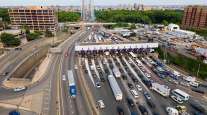Editorial: Good Places to Start
In the nine years that the American Transportation Research Institute has been producing a list of the worst bottlenecks in the United States, three spots have had the inauspicious honor of landing at the top of the list. These same three are consistently awful, even if from year to year one is worse than the others.
Maybe someone should do something.
The ATRI list was mentioned numerous times during last week’s congressional hearing on infrastructure, both by lawmakers and by American Trucking Associations President Chris Spear, who testified before the Senate Commerce Committee alongside other transportation industry stakeholders about the need for federal action on upgrades to everything from roads and bridges, to ports, to access to the internet.
RELATED: Top 100 truck bottlenecks: Texas tops 2019 ATRI list with 13
READ MORE: ATA President Chris Spear urges Senate panel to fund infrastructure projects long term
As is often the case, there was bipartisan support for doing something about the nation’s crumbling infrastructure. But, as is also often the case, the two parties are divided on how to pay for it, and that is a sticking point that won’t soon be resolved.
Here’s an idea: Instead of worrying first about how to pay for the work, perhaps lawmakers should instead look at where there is the greatest need.
If only there were some kind of list to guide them.
The ATRI list, for example, actually ranks the top 100 worst bottlenecks for trucking in the country. That’s a lot of congestion, and a lot of lost productivity. The trucking industry can cite these spots as areas of immediate need. If a price tag could be put on some or all of them, perhaps that could provide lawmakers with a starting point in the funding debate. The debate could be informed by how much specific projects would be projected to cost so that, from there, legislators could work toward identifying funding sources. This could still be done within the structure of a long-term measure, but with specifics noted as to how resources will be tapped and where those resources would be deployed. To keep things fair, perhaps at least one project from each of the 50 states could be included. Lawmakers could even propose which projects they’d like to see included from their states.
We know this may sound ambitious, but just as something must be done about infrastructure upgrades, something also must be done about partisan gridlock on Capitol Hill. On the subject of infrastructure, there is bipartisan commitment to getting something done. If lawmakers could come together on where work must first start, maybe something will.


